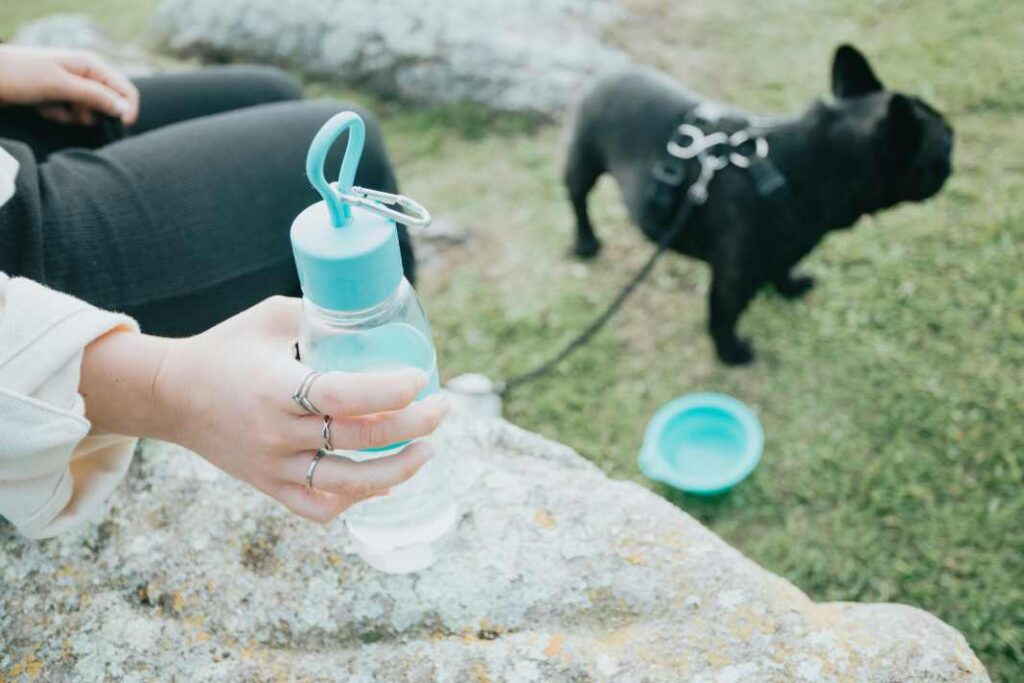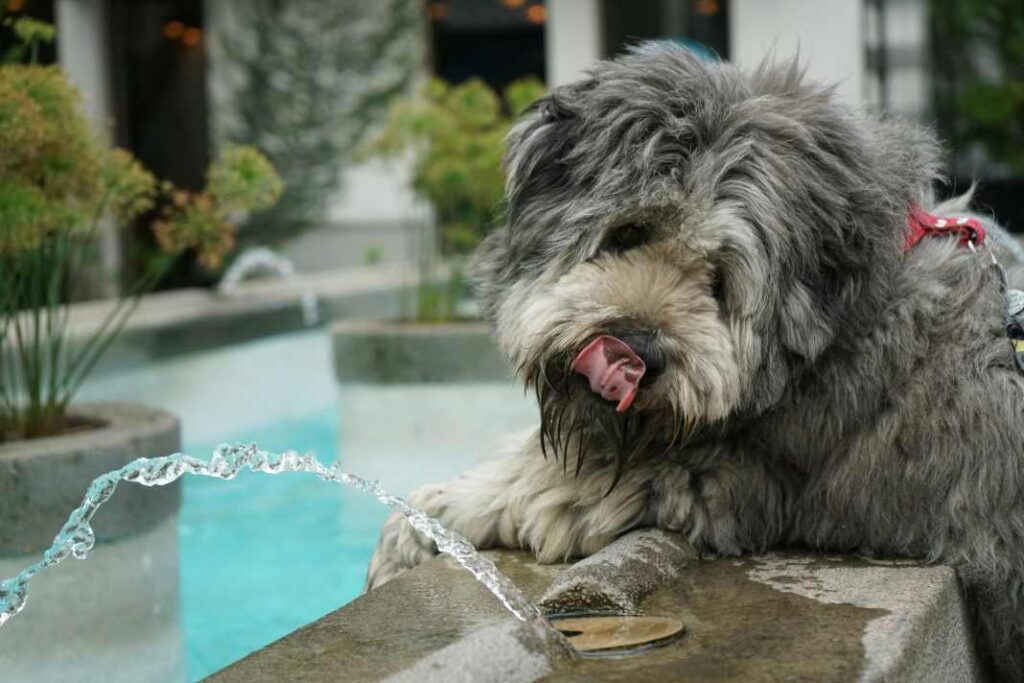This article explores why your dog is always thirsty, delving into the reasons behind excessive thirst in dogs, symptoms of dehydration, and strategies for monitoring and managing your dog’s water intake to tackle this concern.
Overview of Why Your Dog Is Always Thirsty
If you’ve noticed your canine companion making more trips to their water bowl than usual, it’s essential not to simply brush it off as a result of a hot day or a particularly active afternoon. An increase in thirst, medically termed as polydipsia, could be indicative of more than just natural responses to external factors.
Sure, dogs generally require more water after engaging in vigorous play or during the heat of summer, but when the amount of water they consume seems to significantly surpass what’s typical for their activity level and the weather, it’s a signal that shouldn’t be ignored. This heightened thirst could potentially point towards various underlying health issues, ranging from manageable conditions to more serious ailments that require immediate attention.
Recognizing the distinction between normal and excessive thirst in our furry friends is crucial. While it’s typical for a dog to lap up water eagerly after a long walk or on a sunny day, an abrupt or consistent increase in their water intake can serve as an early warning sign. This unusual behavior might be your dog’s way of communicating that something is amiss internally. For instance, diseases such as diabetes mellitus or kidney issues often lead to increased thirst and urination in dogs.
Similarly, conditions like Cushing’s syndrome result in an overproduction of cortisol, making your dog feel the need to drink more water than usual. It’s essential to observe these changes keenly and consider them within the context of your dog’s overall behavior and health status to ensure they receive the care they need promptly. Excessive thirst in dogs can be a sign of various health issues, including dehydration, heat, boredom, diet, medication side effects, and underlying illnesses like diabetes or Cushing’s disease.
Understanding Normal Water Intake for Dogs
Dogs are known to need about 1 ounce of water per pound of body weight per day to maintain their hydration levels. However, this can vary based on several factors including size, diet, and activity level. Smaller dogs, for example, may require more water per pound due to their higher metabolic rates. Additionally, dogs that are more active or live in hotter climates may need more water to stay hydrated and healthy.
A great example of this is a Border Collie who spends their day herding sheep in the summer sun. This dog would need significantly more water than a Chihuahua who lounges indoors most of the day.
Common Causes of Increased Thirst in Dogs

Health Conditions
Several health conditions can lead to excessive thirst in dogs. Diabetes mellitus, kidney disease, and Cushing’s syndrome are among the most common culprits. For instance, Cushing’s disease, which involves the overproduction of cortisol, can significantly increase thirst and urination in dogs. Certain medications, especially steroids, are also known to cause polydipsia as a side effect.
Environmental and Dietary Factors
The type of diet your dog is on can greatly affect their water consumption. Dogs on a primarily dry food diet may find themselves drinking more water to compensate for the lack of moisture in their food. Additionally, diets high in sodium can lead to increased thirst, and in extreme cases, salt poisoning. Environmental factors, such as excessive panting due to heat or after vigorous exercise, can also lead to an increase in thirst due to fluid loss.
Signs of Dehydration and Health Implications
Dehydration in our canine companions is not something to take lightly, as it can pave the way for a host of health complications, including the risk of kidney failure and urinary tract infections. Recognizing the early warning signs can make a world of difference in preventing these issues.
Symptoms such as lethargy, which may manifest as your dog showing less interest in play or walks, sunken eyes, and dry, sticky gums are clear indicators that your furry friend might not be getting enough fluids. These signs are the body’s way of signaling a critical need for water and should prompt immediate action to rehydrate.
But dehydration doesn’t just affect physical health in the short term; it can have lasting impacts on your dog’s well-being. Chronic dehydration can lead to a decline in organ function, impacting the kidneys’ ability to filter waste from the blood and maintain a healthy balance of fluids and electrolytes.
Additionally, a dog that’s constantly dehydrated might appear constantly tired or lethargic, lacking the energy for even the simplest activities. This condition can severely affect their quality of life, making it essential for pet owners to be vigilant about their dog’s hydration levels and take steps to encourage regular water intake.

Monitoring and Managing Your Dog’s Water Intake
Keeping a close eye on how much water your furry friend drinks daily can offer insightful clues into their health and well-being. Establishing a routine of monitoring your dog’s water intake acts as an early warning system for detecting changes in their hydration habits. For instance, a sudden increase in thirst could signal underlying health issues.
To streamline this process, creating a water intake log might seem like a simple step, but it’s an effective strategy. This log can help you track daily consumption and spot any trends or deviations from the norm. Don’t forget to note the context, such as changes in activity level or weather, which can naturally affect their thirst.
Beyond tracking, making water appealing and accessible is key to ensuring your dog stays adequately hydrated. Spill-proof bowls can minimize messes, making them a great choice for enthusiastic drinkers or homes with lively pets. Water fountains, on the other hand, provide a constant flow of fresh water, which can be more enticing for dogs, encouraging them to drink more frequently.
And let’s not overlook the importance of keeping cool during those scorching summer days. Offering ice cubes or frozen treats not only serves as a refreshing snack but also aids in hydration. This approach is particularly effective for dogs that might need a little extra encouragement to drink enough water. Remember, staying hydrated isn’t just about quenching thirst—it’s about keeping your dog happy, healthy, and ready for whatever adventure comes next.
Seeking Veterinary Care and Treatment Options
Observing your dog’s thirst levels can sometimes reveal more than just a simple need for hydration. When your furry friend’s water intake seems unusually high, it’s a signal that shouldn’t be ignored. Scheduling a visit to the veterinarian is a critical first step in addressing this issue. Upon your visit, it’s essential to come prepared with detailed observations of your dog’s drinking habits and any accompanying symptoms, such as increased urination or changes in appetite.
Bringing a recent urine sample can provide valuable insights for initial assessments. Your vet’s approach will likely include a comprehensive examination to pinpoint the cause of your dog’s increased thirst. This may involve a variety of diagnostic tests, including complete blood count (CBC), biochemistry profile, and urinalysis. These tests help in identifying conditions like diabetes mellitus, kidney disease, or Cushing’s syndrome, which are known to cause polydipsia.
Once a diagnosis is established, your veterinarian will discuss the most appropriate treatment plan tailored to your dog’s specific needs. This might range from simple dietary adjustments to more complex medical interventions. For instance, dogs diagnosed with diabetes may require daily insulin injections alongside a carefully monitored diet.
In contrast, cases of kidney disease might necessitate fluid therapy and dietary changes to manage the condition effectively. The goal is to address the underlying issue causing the excessive thirst, thereby improving your dog’s quality of life and well-being. It’s important to follow your vet’s recommendations closely and maintain regular check-ups to monitor your dog’s health and adjust treatment as necessary.
Preventive Measures and Supporting Your Thirsty Dog
Keeping your furry friend healthy and hydrated involves more than just providing them with a bowl of water. Regular veterinary check-ups play a pivotal role in the early detection and management of health conditions that may lead to increased thirst. These visits allow your vet to catch subtle changes that might not be immediately obvious to even the most attentive pet owners.
Beyond these check-ups, consulting with your veterinarian about the optimal diet for your dog is essential. A well-balanced diet not only supports your dog’s overall health but can also ensure they’re receiving adequate hydration. Dogs on certain diets, especially those high in sodium or dry food, might require additional water intake.
To further support your thirsty dog, consider making their water more enticing. A simple trick is to add a splash of flavorless broth or low-sodium chicken broth to their water bowl. This can transform plain water into a more appealing drink, encouraging your dog to hydrate more frequently.
It’s a small step that can make a big difference, especially during hotter months or for dogs that are naturally less inclined to drink adequate amounts of water. Remember, keeping your dog hydrated is not just about quenching their thirst—it’s about keeping them healthy and preventing potential health issues related to dehydration.

Conclusion and Importance of Addressing Excessive Thirst
Recognizing and addressing why your dog is always thirsty is crucial for their health and well-being. This condition, known as polydipsia, isn’t merely a matter of drinking more water than usual. It’s often a harbinger of underlying health issues that could range from diabetes mellitus to kidney disease or Cushing’s syndrome.
Ignoring these signs can lead to dire consequences, including dehydration that could further exacerbate existing health problems or even lead to new ones. By staying informed about how much water your dog should be drinking based on their size, activity level, and the climate they live in, you can better gauge when their thirst is becoming abnormal.
Moreover, being proactive about your dog’s hydration goes beyond just providing them with water. It involves understanding the potential health implications of excessive thirst and being vigilant for other accompanying symptoms such as changes in urination habits, lethargy, or loss of appetite. Early intervention is key.
Scheduling regular veterinary check-ups, keeping a log of your dog’s water intake, and being observant of any drastic changes in their drinking behavior can make a significant difference in managing or even preventing health issues linked to excessive thirst. Remember, your attentiveness and prompt action can safeguard your dog’s health, ensuring they lead a happy, hydrated, and healthy life.
Further Reading on This Topic:
Keeping Your Pup Hydrated: How Much Water Do Dogs Need to Drink Every Day
Hydrate Hound: The Essential Guide to Keeping Your Dogs Water Bowl Full
Disclaimer: The information provided in this blog post is for educational purposes only and is not intended to be a substitute for professional veterinary advice, diagnosis, or treatment. While we strive to provide accurate and up-to-date information regarding dog health issues, symptoms, and treatment options, we are not veterinarians. Always seek the advice of your veterinarian or other qualified animal health provider with any questions you may have regarding a medical condition or treatment and before undertaking a new health care regimen for your pet. Never disregard professional veterinary advice or delay seeking it because of something you have read on this blog.




